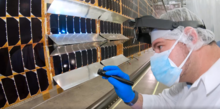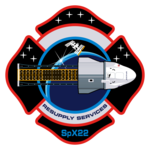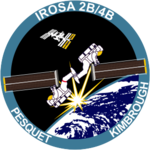Roll Out Solar Array


The Roll Out Solar Array (ROSA) and its larger version ISS Roll Out Solar Array (iROSA) are lightweight, flexible power sources designed by NASA to be deployed and used in space.[1]
This new type of solar array provides much more energy than traditional solar arrays at much less mass.[2] Traditional solar panels used to power satellites are bulky, with heavy panels folded together using mechanical hinges. Given a space-bound payload is limited in its mass and volume by necessity, ROSA is 20 percent lighter (with a mass of 325 kg (717 lb))[3] and one-fourth the volume of rigid panel arrays with the same performance.[4]
ROSA is a flexible and rollable solar array that operates the same way a measuring tape unwinds on its spool. The new solar array design rolls up to form a compact cylinder for launch with significantly less mass and volume, potentially offering substantial cost savings as well as an increase in power for satellites. ROSA has a center wing made of a flexible material which support the strings of photovoltaic cells that produce electricity. Both the sides of the wing have a narrow arm that extends through the length of the wing to provide support to the array, called a high strain composite boom. The booms look like split tubes made of a stiff composite material, flattened and rolled up lengthwise. The array does not need any motor to unfurl. This is achieved using the potential energy stored in the booms that is released as each boom transitions from a coil shape to a straight support arm. The solar wings are then deployed due to strain energy in rolled booms that are present at the two ends of the structure.
Patent[]
Brian R. Spence and Stephen F. White were the first persons to patent the idea of the Roll Out Solar Array on January 21, 2010.[5] They received a patent for this work on April 1, 2014.[5]
History[]

NASA tested the ROSA technology in vacuum chambers on Earth several years ago,[when?] but still decided to test it in space on June 18 of 2017. ROSA launched aboard SpaceX CRS-11 on 3 June.[3] Over the weekend of June 17–18, 2017, engineers on the ground remotely operated the International Space Station's robotic Canadarm2 to extract the Roll Out Solar Array (ROSA) experiment from the SpaceX Dragon resupply ship. After the observation the mechanism was not planned to be retrieved back to earth. The solar array unfurled June 18, extending by tensioning booms on both sides of the 1.6-meter-wide wing.[6] NASA decided to conduct continuous tests for a week and observe its consequences. Engineers observed the behavior of the solar array as it was exposed to extreme temperature swings through the ISS's orbit. Vibrations and oscillations were also mechanically introduced to assess the array's response to structural loads.[7] Subsequent to the experiments, ground controllers were unable to lock the solar panel in its stowed configuration. The solar array was therefore jettisoned from the International Space Station.[8]
In June 2021, two new solar iROSA panels were installed on the International Space Station's P6 truss mast cans.[9] The two operations took six hours each to complete and were carried out on three spacewalks by astronauts Shane Kimbrough and Thomas Pesquet.[10][11][12][13] The new arrays are intended to give the station a total of 120 kilowatts of additional augmented power during daytime orbit. [14]
Applications[]
ROSA is very compact in size and, due to its large power generation capacity, reliable for future missions, including for interplanetary travel which needs huge amounts of energy.
Over time, the photovoltaic cells on the ISS' existing Solar Array Wings on the Integrated Truss Structure have degraded gradually, having been designed for a 15-year service life. This is especially noticeable with the first arrays to launch, with the P6 and P4 Trusses in 2000 and 2006.
To augment the wings, three pairs of scaled-up versions known as iROSA are planned by NASA to launch in the trunk of the SpaceX Dragon 2 cargo spacecraft from early June 2021 to late 2022, aboard SpaceX CRS-22, CRS-25 and CRS-26. These arrays are intended to be deployed along the central part of the wings up to two thirds of their length.[15]
Work to install iROSA's support brackets on the P6 truss mast cans holding the Solar Array Wings was initiated by the crew members of Expedition 64 in late February 2021.[16][15] After the first pair of arrays were delivered in early June,[12] a spacewalk on 16 June by members Kimbrough and Pesquet of Expedition 65 to place one iROSA array on the 2B power channel and mast can of the P6 truss[17] was successful until a spacesuit computer malfunctioned and the iROSA encountered technical problems with deployment, resulting in the spacewalk being cut short early, having lasted 7 hours and 15 minutes.[18][19] Two more spacewalks, on 20 and 25 June and lasting between 6 hours 28 minutes and 6 hours 45 minutes,[19] saw Kimbrough and Pesquet complete the first iROSA's deployment as well as the installation and deployment of the second iROSA on the 4B power channel and mast can.[19][9][10][13]
The next pair of iROSA assemblies are due to be installed with one of them on the P4 Truss. Astronauts Akihiko Hoshide and Mark Vande Hei of Expedition 65 were slated to carry out the preceding bracket installation on 24 August.[20][needs update] It was postponed to September after Vande Hei encountered "minor medical issues".[21]

The Power and Propulsion Element of the Lunar Gateway and Double Asteroid Redirection Test (DART) mission will use ROSA technology to power its solar electric propulsion.
The ROSA on DART will enable the spacecraft to navigate through space and reach the Didymos asteroid system. The flexible and rollable modular wings are lighter, more compact and stiffer in space and smaller than iROSA. Each array will slowly unfurl to reach 28 feet (8.53 m) in length. DART will be the first probe to fly the new arrays, paving the way for their use on future missions. Redwire delivered ROSA to APL in May 2021 and worked closely with the APL team for some weeks to carefully install them onto the spacecraft. The installation was completed on 13 August 2021.[22]

A small portion of each DART solar array is configured to demonstrate Transformational Solar Array technology, which has very-high-efficiency solar cells and reflective concentrators providing three times more power than current solar array technology.[23][24]
Missions[]
CRS-11

SpaceX CRS-11 mission patch [a]
CRS-22

SpaceX CRS-22 Patch [b]

ISS iROSA 2B and 4B patch mission patch
Double Asteroid Redirection Test

Dart Mission patch [c]
DART's Roll Out Solar Array (ROSA) developement

ROSA to be installed on DART satellite

Roll-Out Solar Arrays (ROSA) installed on dart mission
See also[]
- Solar panels
- Solar array
- Electrical system of the International Space Station
- Redwire
References[]
- ^ "Roll Out Solar Array". Retrieved 21 June 2017.
- ^ Rory Barrett, Douglas Campbell (2006). "Development of a Passively Deployed Roll-Out Solar Array". Defense Technical Information Center, 2006.
- ^ Jump up to: a b "SpaceX CRS-11 Mission Overview" (PDF). NASA. Retrieved 3 June 2017.
- ^ "Converting Sunlight into Electricity: Deployable Space Systems Inc". HighBeam. Archived from the original on 6 March 2018. Retrieved 1 December 2016.
- ^ Jump up to: a b "Directionally controlled elastically deployable roll-out solar array". www.google/patents. Retrieved 1 April 2014.
- ^ Clark, Stephen (30 June 2017). "Prototype solar array jettisoned as Dragon capsule prepares for trip home". SpaceFlightNow. Retrieved 8 February 2018.
- ^ Mathewson, Samantha. "NASA Tests Flexible Roll-Out Solar Array on Space Station". space.com. Retrieved 20 June 2017.
- ^ "Jettison of ROSA". space.com. Retrieved 27 June 2017.
- ^ Jump up to: a b agencies, Guardian staff and (2021-06-21). "ISS astronauts complete six-hour spacewalk to install solar panels". the Guardian. Retrieved 2021-06-23.
- ^ Jump up to: a b Strickland, Ashley (20 June 2021). "Astronauts install new solar panels in 6-hour spacewalk on International Space Station". CNN. Time Warner. Retrieved 2 July 2021.
- ^ "Current and Future Operations and Challenges with International Space Station" (PDF). ISS Program Office. NASA. 15 Oct 2020. Retrieved 2 July 2021.
- ^ Jump up to: a b Clark, Stephen (3 June 2021). "SpaceX cargo ship launches on mission to upgrade space station electrical grid". Spaceflight Now. Retrieved 2 July 2021.
- ^ Jump up to: a b Pearlman, Robert Z. (25 June 2021). "Spacewalking astronauts deploy second new solar array for space station". Space.com. Future US Inc. Retrieved 26 June 2021.
- ^ Garcia, Mark (2021-01-11). "New Solar Arrays to Power NASA's International Space Station Research". NASA. Retrieved 2021-06-23.
- ^ Jump up to: a b Garcia, Mark (11 January 2021). "New Solar Arrays to Power NASA's International Space Station Research". NASA. Retrieved 26 April 2021.
 This article incorporates text from this source, which is in the public domain.
This article incorporates text from this source, which is in the public domain.
- ^ "Expedition 64 Information Page". Spacefacts.de. 10 May 2021. Retrieved 17 June 2021.
- ^ Garcia, Mark (16 June 2021). "Spacewalk to Install First New Solar Array Concluded". NASA. Retrieved 17 June 2021.
 This article incorporates text from this source, which is in the public domain.
This article incorporates text from this source, which is in the public domain.
- ^ "Hardware, Spacesuit Difficulties Stall Ambitious ISS Spacewalk". Aviation Week. Informa Markets. 17 June 2021. Retrieved 17 June 2021.
- ^ Jump up to: a b c "Expedition 65 Information Page". Spacefacts.de. 17 June 2021. Retrieved 17 June 2021.
- ^ "Upcoming NASA Live Events". NASA. 23 August 2021. Retrieved 23 August 2021.
- ^ staff, Associated Press of New York (24 August 2021). "NASA delays ISS spacewalk due to astronaut's medical issue". The Guardian. Guardian News and Media Ltd. Retrieved 27 August 2021.
- ^ Talbert, Tricia (2021-08-11). "DART Gets Its Wings with Innovative Solar Array Technology and Camera". NASA. Retrieved 2021-08-13.
- ^ Behind the Scenes: Inspecting DART's Roll-Out Solar Array (ROSA) Technology, retrieved 2021-08-13
- ^ "DART has a solar array experiment called transformational solar array on its roll out solar array panel". dart.jhuapl.edu. Retrieved 2021-08-13.
- ^ ROSA test mission
- ^ 1st iROSA Mission
- ^ 1st heliocentric mission by ROSA and test mission of Transformational Solar Array
 This article incorporates public domain material from websites or documents of the National Aeronautics and Space Administration.
This article incorporates public domain material from websites or documents of the National Aeronautics and Space Administration. This article incorporates public domain material from websites or documents of the National Aeronautics and Space Administration.
This article incorporates public domain material from websites or documents of the National Aeronautics and Space Administration.
External links[]
| Wikimedia Commons has media related to Roll-Out Solar Array (ROSA). |
- NASA programs
- Solar energy
- Redwire






